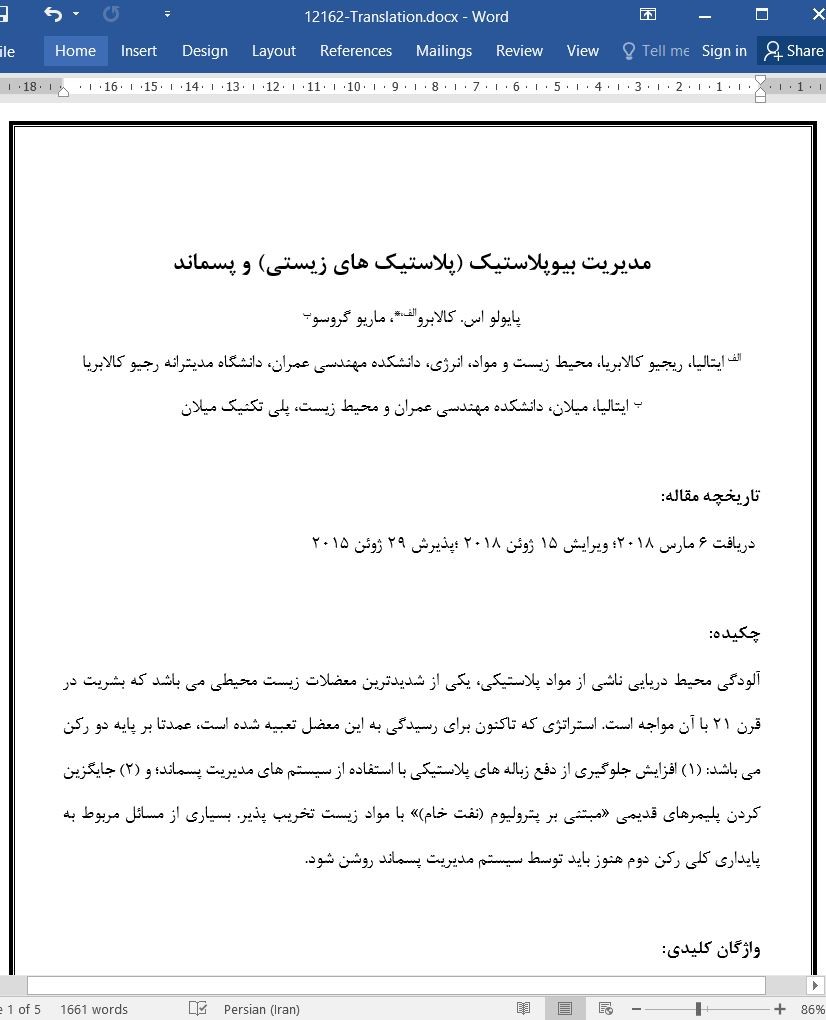
مدیریت بیوپلاستیک (پلاستیک های زیستی) و پسماند
چکیده
آلودگی محیط دریایی ناشی از مواد پلاستیکی، یکی از شدیدترین معضلات زیست محیطی می باشد که بشریت در قرن 21 با آن مواجه است. استراتژی که تاکنون برای رسیدگی به این معضل تعبیه شده است، عمدتا بر پایه دو رکن می باشد: (1) افزایش جلوگیری از دفع زباله های پلاستیکی با استفاده از سیستم های مدیریت پسماند؛ و (2) جایگزین کردن پلیمرهای قدیمی «مبتنی بر پترولیوم (نفت خام)» با مواد زیست تخریب پذیر. بسیاری از مسائل مربوط به پایداری کلی رکن دوم هنوز باید توسط سیستم مدیریت پسماند روشن شود.
آلودگی محیط دریایی ناشی از مواد پلاستیکی، یکی از شدیدترین معضلات زیست محیطی می باشد که بشریت در قرن 21 با آن مواجه است. اکنون این امر واضح است که علاوه بر سایر اثرات زیانبار مانند مرگ و میر گونه های در معرض خطر مانند پستانداران دریایی و لاک پشت ها، میکروپلاستیک هایی که از زباله های پلاستیکی نشأت می گیرند، می توانند به راحتی وارد زنجیره غذایی انسان شوند. همچنین به طور دقیق تشخیص داده شده است که اکثریت قریب به اتفاق پلاستیک های موجود در اقیانوس ها (70-80٪) در واقع از زمین منشاء می گیرند.
Abstract
Pollution of the marine environment due to plastic materials is one of the most severe environmental problems humanity has to face in the 21st century. The strategy devised until now to address this issue is mainly based on two pillars: (1) increasing the interception of discarded plastic wastes by waste management systems; and (2) substituting the traditional “petro-based” polymers with biodegradable ones. Many issues on the overall sustainability of the second option by the waste management system must still be clarified.
Pollution of the marine environment due to plastic materials is one of the most severe environmental problems humanity has to face in the 21st century. It is now clear that, in addition to other deleterious effects like causing the death of endangered species, such as sea mammals and turtles, microplastics originating from plastic debris can easily enter the human food chain. It is also well known that the vast majority of plastics found in the oceans (70–80%) actually originates on land.
- اصل مقاله انگلیسی با فرمت ورد (word) با قابلیت ویرایش
- ترجمه فارسی مقاله با فرمت ورد (word) با قابلیت ویرایش، بدون آرم سایت ای ترجمه
- ترجمه فارسی مقاله با فرمت pdf، بدون آرم سایت ای ترجمه

